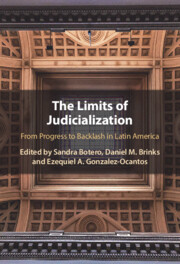Book contents
- The Limits of Judicialization
- The Limits of Judicialization
- Copyright page
- Contents
- Figures
- Tables
- Contributors
- Acknowledgments
- 1 Working in New Political Spaces
- 2 Critical Disconnects
- 3 When Winning in the Courts Is Not Enough
- 4 Forms of Countermovement and Counter-Reform in Latin America
- 5 Backlash against State Strengthening Reforms
- 6 Backlash against Corporate Accountability for Grave Human Rights Violations in Colombia
- 7 Courting Judicial Legitimacy
- 8 Family Ties and Nepotism in the Mexican Federal Judiciary
- 9 Judicial Corruption
- 10 Kickbacks, Crackdown, and Backlash
- 11 Turning Corruption Trials into Political Tools in the Name of Transparency
- 12 Fighting Corruption, Dismantling Democracy
- 13 Prosecutorial Agency, Backlash and Resistance in the Peruvian Chapter of Lava Jato
- Index
- References
6 - Backlash against Corporate Accountability for Grave Human Rights Violations in Colombia
Published online by Cambridge University Press: 11 August 2022
- The Limits of Judicialization
- The Limits of Judicialization
- Copyright page
- Contents
- Figures
- Tables
- Contributors
- Acknowledgments
- 1 Working in New Political Spaces
- 2 Critical Disconnects
- 3 When Winning in the Courts Is Not Enough
- 4 Forms of Countermovement and Counter-Reform in Latin America
- 5 Backlash against State Strengthening Reforms
- 6 Backlash against Corporate Accountability for Grave Human Rights Violations in Colombia
- 7 Courting Judicial Legitimacy
- 8 Family Ties and Nepotism in the Mexican Federal Judiciary
- 9 Judicial Corruption
- 10 Kickbacks, Crackdown, and Backlash
- 11 Turning Corruption Trials into Political Tools in the Name of Transparency
- 12 Fighting Corruption, Dismantling Democracy
- 13 Prosecutorial Agency, Backlash and Resistance in the Peruvian Chapter of Lava Jato
- Index
- References
Summary
Colombia has faced over fifty years of internal armed conflict, resulting in more than 9 million victims and dozens of peace negotiations with different illegal armed groups. With the demobilization of the largest paramilitary group in 2003 (Autodefensas Unidas de Colombia), the country saw renewed accountability efforts that highlighted the role of businesspeople in the violence. A norm of business accountability for past atrocities started to emerge with a number of convictions in the courts. When the government launched negotiations with the FARC guerrilla group in 2012, many observers expected continuity in this path of increased accountability of economic actors. But the path was severed. This chapter describes the ebbs and flows of business accountability in Colombia, looking at the role of the human rights movement in securing higher levels of accountability, and the emergence of an organized opposition from the business community to stop the process. The chapter argues that this business countermovement is a result of the success of the human rights movement in the courts, which led to convictions and brought the matter to the public eye. All of this created a more tangible threat to the interests of economic actors, leading to the subsequent backlash.
- Type
- Chapter
- Information
- The Limits of JudicializationFrom Progress to Backlash in Latin America, pp. 139 - 163Publisher: Cambridge University PressPrint publication year: 2022



